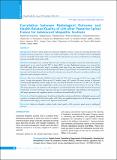Please use this identifier to cite or link to this item:
https://hdl.handle.net/20.500.14356/1037| Title: | Correlation between Radiological Outcome and Health Related Quality of Life after Posterior Spinal Fusion for Adolescent Idiopathic Scoliosis |
| Authors: | Chaudhary, Rajesh Kumar Kaucha, Deepak Banskota, Bibek Barakoti, Ram Krishna Banskota, Ashok Kumar |
| Issue Date: | 2021 |
| Publisher: | Nepal Health Research Council |
| Article Type: | Original Article |
| Keywords: | Adolescent idiopathic scoliosis Health related quality of life Posterior spinal surgery Radiological outcome |
| Series/Report no.: | Jan-March, 2021;3245 |
| Abstract: | Abstract Background: Posterior spinal surgery for adolescent idiopathic scoliosis is aimed at correcting deformity and stopping deformity progression to improve the health related quality of life. The correlation between radiological outcome and health related quality of life is yet unclear. This study aimed to assess the correlation between radiological outcome and health related quality of life. Methods: A descriptive cross-sectional study of 31 cases of adolescent idiopathic scoliosis who underwent posterior spinal surgery at our center from July 2013 to August 2019, was done. Radiological outcomes were measured by the Cobb’s angle before and after surgery in standing whole spine X-ray and compared by paired t-test. Health related quality of life was measured by Scoliosis Research Society-30 questionnaire. Correlation between radiological outcomes and Scoliosis Research Society-30 and its domains were assessed by Pearson’s correlation coefficient, and Spearman’s rank correlation coefficient. Results: There were 18 females (58.06%) and 13 males (41.93%) with a mean age of 14.81 years (range 12-18 years). Average post-operative follow-up was 37 months (range 6-82 months).The mean amount of deformity correction post-operatively was 460 (range 300-740). The mean of total SRS-30 score was 137.64±7.84. The post-operative Cobb angle correlated significantly with the mean total Scoliosis Research Society-30 score (p=0.046). Self-image/appearance and satisfaction with management correlated significantly with residual deformity and amount of deformity correction. Self-image/appearance and pain correlated significantly with satisfaction with management. Self-image/appearance had a significant positive correlation with mental health (p=0.004). Conclusions: Posterior spinal surgery for adolescent idiopathic scoliosis provided better radiological outcomes, and a positive correlation with health related quality of life. There was significant improvement of self-image/appearance and satisfaction after surgery, which in turn, improved mental health. Keywords: Adolescent idiopathic scoliosis; health related quality of life; posterior spinal surgery; radiological outcome |
| Description: | Original Article |
| URI: | http://103.69.126.140:8080/handle/20.500.14356/1037 |
| ISSN: | Print ISSN: 1727-5482; Online ISSN: 1999-6217 |
| Appears in Collections: | Vol. 19 No. 1 (2021): Vol. 19 No. 1 Issue 50 Jan-Mar 2021 |
Files in This Item:
| File | Description | Size | Format | |
|---|---|---|---|---|
| 3245-Manuscript-21545-1-10-20210425.pdf | Fulltext Article. | 234.46 kB | Adobe PDF |  View/Open |
Items in DSpace are protected by copyright, with all rights reserved, unless otherwise indicated.
